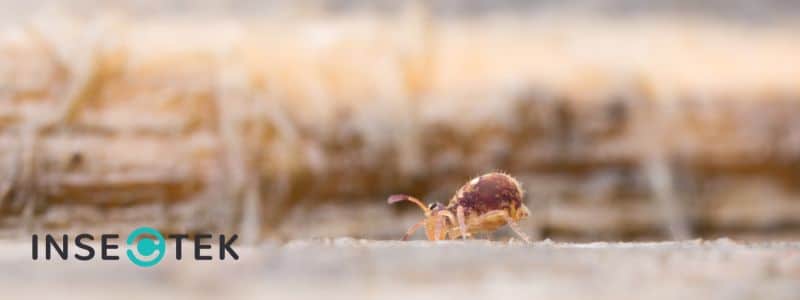Prepare to journey into the miniature universe of springtails and discover why they are worth your attention. We’ll answer the following questions:
- What is a springtail?
- Are springtails good or bad?
- What problems do springtails cause?
- Is it normal to have springtails in your house?
- How do you get rid of Springtails?
What is a Springtail?

A springtail is a soil-dwelling arthropod that belongs to the class Collembola. They’re less than 6 millimeters long with six legs and dark coloring, typically brown, grey, or black. Although, some springtail species can appear white and brightly colored.
Several species of springtails exist, including snow fleas, orchesella cincta, orchesella villosa, and podura aquatica, among others. Their life cycle follows three stages: egg, nymph, and adult.
Springtails are wingless insects and can’t fly. Their elongated body structure is rounded and soft, making it easy for them to be crushed. Springtails jump several inches using a unique forked structure called a furcula attached under their abdomen segments. They then use a tube-like structure called a collophore to stabilize themselves as they jump from surface to surface. This mechanism allows them to escape predators and is where they coined the name “springtail.”
It’s common for people to mistake them for fleas due to their ability to jump from place to place and their similar size. Unlike fleas, springtails don’t consume blood. They feed on decaying organic matter, fungi, algae, bacteria, soil, and leaf litter. Springtails are found in high moisture areas and organic debris and will seek out these types of environments.
Are Springtails Good or Bad?

Springtails are beneficial to the environment because they’re natural recyclers. They feed on organic matter and release nutrients into the soil to maintain plant health. Interestingly enough, if you find springtails in your home, they can alert you to moisture issues or water damage. They thrive in moist conditions and will be attracted to these areas.
Some people may have allergies to springtails that cause skin irritations and respiratory problems in the presence of an infestation. They aren’t a significant threat to plants but can chew through roots and weaken their sturdiness. Springtails don’t damage the home and don’t bite or sting humans or animals, nor do they carry diseases. Overall, they’re not a serious pest compared to others, but they can disrupt your home by crawling around and invading your space in great numbers.
What Problems Do Springtails Cause?
Springtails are harmless and don’t damage anything in your house. The main problem they present is being an annoyance. They’re found in overwatered potted plants and other moist environments. Springtails may cause plants to wilt or stunt their growth in large numbers, but they don’t cause significant damage.
Is it Normal to Have Springtails in Your House?
Springtails in the home are a common occurrence. They’re drawn to moisture and light and may enter through cracks in windows and doors. Springtails are attracted to leaky pipes, damp basements, and excess condensation. If you see excess springtails in your house, this may indicate possible moisture issues or water damage.
How Do You Get Rid of Springtails?

Springtails are incredibly resilient insects with excellent survival skills. The best way to get rid of them in the home is to target the spots they thrive in. Identify and eliminate moisture.
Springtails hang around leaky pipes, overflowing potted plants, and other built-up moisture like plumbing problems and poor ventilation. Fix any water-related problems to deter them. You can also wipe down infected areas with store-bought remedies like cider vinegar and baking soda. These will kill off springtail infestations, and fixing moisture issues will keep them from returning.







